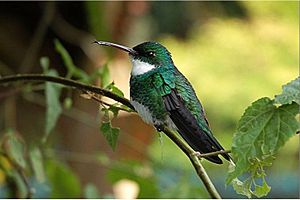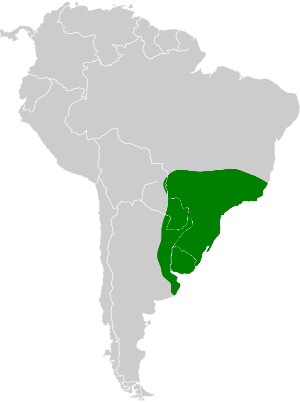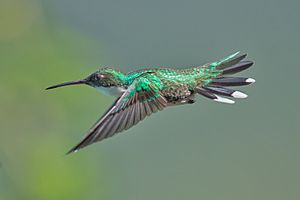White-throated hummingbird facts for kids
Quick facts for kids White-throated hummingbird |
|
|---|---|
 |
|
| Conservation status | |
| Scientific classification | |
| Genus: |
Leucochloris
|
| Species: |
albicollis
|
 |
|
The white-throated hummingbird (Leucochloris albicollis) is a beautiful and tiny bird. It's a type of hummingbird known for its bright colors. You can find this hummingbird in parts of Argentina, Brazil, Paraguay, and Uruguay in South America.
Contents
About the White-throated Hummingbird's Name
The French bird expert Louis Jean Pierre Vieillot first described this hummingbird in 1818. He called it Trochilus albicollis. The name albicollis comes from Latin words meaning "white" (albus) and "neck" (collum). This perfectly describes its white throat!
Later, in 1854, Ludwig Reichenbach created the group (genus) called Leucochloris. This name comes from ancient Greek words: leukos meaning "white" and chloros meaning "green". The white-throated hummingbird is the only bird in this special group. It doesn't have any different types (subspecies).
What Does the White-throated Hummingbird Look Like?
This hummingbird is about 10 to 11.5 centimeters (4 to 4.5 inches) long. Male hummingbirds weigh between 5 to 8 grams, which is about the same as two pennies! Females are a bit lighter, weighing around 4.5 grams.
Adult birds have a straight beak that's not too long. The top part of their beak is blackish, and the bottom part is red with a black tip.
- Males: Their upper body is a shiny golden-green to bronze-green. Their tail feathers are golden-green or bright green, with the outer ones being blackish-green with white bands. Their chin is bright green with white edges, and their throat is white. Their chest is bright green to golden-green. The middle of their belly is white, with golden-green or bronze-green on the sides.
- Females: They look very similar to males but are not as bright or glittery.
- Young Birds: Baby hummingbirds have grayish-brown underparts with less white. Their tail feathers have brownish tips.
Where Do White-throated Hummingbirds Live?
You can find the white-throated hummingbird in eastern Paraguay, southeastern Brazil (from Minas Gerais and Espírito Santo south), Uruguay, and northeastern Argentina.
They like places that are partly open, like the edges of forests, marshy areas, scrublands, parks, and even gardens. They usually live from sea level up to about 1,000 meters (3,300 feet) high. Sometimes, they are seen even higher, with one record at 2,100 meters (6,900 feet)!
White-throated Hummingbird Behavior
Movement and Travel
Most white-throated hummingbirds stay in one area. However, some have been seen moving short distances from their usual homes.
What Do White-throated Hummingbirds Eat?
These hummingbirds drink nectar from many different kinds of plants. They like both native plants and those brought in by people. They seem to especially love plants from the Bromeliad family, like Quesnelia testudo and Tillandsia aeranthos. They also help pollinate plants like Siphocampylus sulfureus. Besides nectar, they also catch insects while flying from a perch.
Reproduction and Life Cycle
The breeding season for the white-throated hummingbird is from October to March. The female builds a cup-shaped nest using plant fluff and moss. She uses spiderwebs to hold it all together and decorates the outside with lichen. The nest is usually placed on a flat branch of a small tree or bush.
The female lays two eggs and sits on them (incubates) for about 14 days. The baby birds leave the nest (fledge) about 20 to 25 days after they hatch.
Vocalization: What Sounds Do They Make?
The white-throated hummingbird's song is a series of 4 to 10 high-pitched, buzzing notes. The first note is often the loudest. They also make calls that sound like "dry chips" and a high-pitched, metallic rattling sound that goes down in pitch.
Status and Conservation
The IUCN (International Union for Conservation of Nature) has listed the white-throated hummingbird as a species of "Least Concern." This means they are not currently in danger of disappearing. We don't know exactly how many there are or if their numbers are changing. No immediate threats have been found.
They are considered "especially common" in the southeastern part of their range. They have also adapted well to living in places changed by humans, like parks and gardens. We know less about their numbers at the western edge of where they live.
Images for kids
See also
 In Spanish: Picaflor garganta blanca para niños
In Spanish: Picaflor garganta blanca para niños




